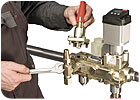
Now a technology limits such work to a couple of welds and puts all the components onto a single, compact body only a foot or so long, in which each component can be removed for service and replaced without another round of welding.
“This is the next generation of valves,” said Brian Davis, vice president for Industrial Refrigeration at Danfoss, which developed the ICF Valve Station.
“When you choose the ICF, there is a lot you don’t do: no pipe cutting, no disassembling components to protect them from welding heat, no welding the station components together, no parts to reassemble after welding, and no flanges or gaskets to contend with.”
He noted that the valve station is lighter than a conventional valve setup because no pipe is needed between the components, and the pressure drop is lower. In effect, the factory-assembled station “brings together all the functions you need on a single, compact body with socket weld connections up to one and a half inches, yet each component is individually removable,” he said.
The ICF Valve Station also features a working pressure of 754 psi and a minimum working temperature of -76°F. It is suitable for use in R-717, all common HFC refrigerants, and CO2. Standard features include zinc chromate corrosion protection and stainless steel trim.
LEAK CONTROL
One reason the technology was developed was to curb the leaks that can sometimes occur in welding and with valves spread across a refrigeration line.“Pipe flanges and valves are a source for leaks and leaking ammonia can accelerate valve/pipe corrosion, not to mention the inherent safety concerns of ammonia leaks,” said Davis. “Valves must be easier to troubleshoot and service for today’s 24/7 operations with limited resources.”
Research engineers considered technologies such as flanged bodies, which had been used for many years; steel body valves; and direct-welded control valves. They also studied the traditional valve train with various components installed along a lengthy refrigeration line.
At that point, a decision was made to try something different. The result was the ICF complete valve station.
“This is new technology,” said Davis. “It is a complete valve station with precision casting that is preconfigured for either four or six modules, manual or electronic valves, three-quarter- to one-and-a-half-inch connections, that is all less than 16 inches long.” He noted that side ports are available for sight glasses, pressure sensors, gauge valves, and drain valves.
The functions in the housing include stop valve, strainer, solenoid, manual opener, hand regulator, electronic expansion valve, motorized valve, check valve, stop check, and blind cover.
UPSIDE-DOWN PRACTICALITY
The ICF requires some valve modules, such as stop valves and stop check valves, to be mounted upside down, Davis said. “For a conventional stop valve, we would discourage upside-down mounting as dirt can work its way into the bonnet threads and compromise the valve.“However, in the new technology the hand valve cone is designed as a cylinder with a very tight, 50-micron clearance with the body that prevents the dirt from entering the threads.”
Applications for the valve station include liquid lines (pipe recirculation and direct expansion); hot gas defrost for pump recirculation evaporators; liquid make-up lines for recirculation systems; and compressor liquid injection.
Installation is done by directly welding the unit into the pipe. There is no disassembly for the welding. For servicing, there is four-bolt access to the modules. Isolation is typically with stop valves in the first and last position. There are also vent and drain connections.
For more information, visit www.danfoss.com/North_America for more product information. The product was one of the winners of the 2007 Innovation Award, presented in conjunction with the International Air-Conditioning, Heating, Refrigerating Exposition.
Publication date: 12/25/2006


Report Abusive Comment